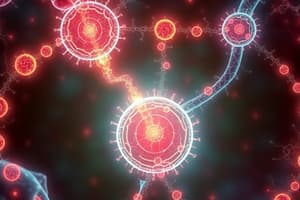Podcast
Questions and Answers
What is the main function of the Tricarboxylic Acid (TCA) cycle?
What is the main function of the Tricarboxylic Acid (TCA) cycle?
- To synthesize citrate
- To break down citrate into carbon atoms
- To create energy from organic molecules (correct)
- To form succinate dehydrogenase
Which enzyme converts citrate into cis-aconitate in the TCA cycle?
Which enzyme converts citrate into cis-aconitate in the TCA cycle?
- Isocitrate dehydrogenase
- Alpha-ketoglutarate dehydrogenase
- Succinate dehydrogenase
- Aconitase (correct)
What is the role of succinyl coenzyme A (succinyl CoA) in the TCA cycle?
What is the role of succinyl coenzyme A (succinyl CoA) in the TCA cycle?
- Generates NADH
- Forms citrate
- Breaks down succinate
- Contributes to the electron transport chain (correct)
Which of the following is NOT a product generated during the TCA cycle?
Which of the following is NOT a product generated during the TCA cycle?
Which compound is formed from alpha-ketoglutarate in the TCA cycle?
Which compound is formed from alpha-ketoglutarate in the TCA cycle?
What happens to citrate in the TCA cycle?
What happens to citrate in the TCA cycle?
What happens to GDP during the chemical transformation described?
What happens to GDP during the chemical transformation described?
Which enzyme is involved in the oxidation of succinate to yield fumarate?
Which enzyme is involved in the oxidation of succinate to yield fumarate?
What role does malate dehydrogenase play in the TCA cycle?
What role does malate dehydrogenase play in the TCA cycle?
Which molecules are synthesized as a result of the TCA cycle directing carbon atoms?
Which molecules are synthesized as a result of the TCA cycle directing carbon atoms?
Why do some organisms require extra steps like fermentation in addition to the TCA cycle?
Why do some organisms require extra steps like fermentation in addition to the TCA cycle?
What valuable insights can understanding the TCA cycle provide about cells?
What valuable insights can understanding the TCA cycle provide about cells?
Study Notes
Unraveling Energy Production's Central Hub: The Tricarboxylic Acid Cycle
At the heart of life's metabolic machinery lies a cyclical dance involving acids and carbon atoms—the tricarboxylic acid (TCA) cycle or Krebs cycle, named after its discoverer, Hans Krebs. This essential process occurs in the mitochondria of nearly all living cells and is responsible for creating energy from the chemical bonds within organic molecules like glucose and fatty acids.
The TCA cycle begins with three small molecular fragments called citrate (or citric acid), synthesized when two three-carbon molecules (acetyl-CoA) combine with oxaloacetate, a four-carbon compound. Citrate will eventually break apart into its constituent carbon atoms and generate ATP (adenosine triphosphate) through cellular respiration. Here's how the TCA cycle works step by step:
-
In the first reaction, aconitase converts citrate into cis-aconitate. Two enzymes, isocitrate dehydrogenase and alpha-ketoglutarate dehydrogenase, subsequently remove hydrogen atoms, generating NADH (nicotinamide adenine dinucleotide) and FADH2 (flavin adenine dinucleotide). These electron carriers transfer their electrons along the electron transport chain, thereby producing more ATP.
-
Next, alpha-ketoglutarate forms succinyl coenzyme A (succiny CoA) using succinate dehydrogenase, which also contributes to the electron transport chain. Succinyl CoA then loses a glycine-like fragment through succinic thiokinase, forming succinate. This chemical transformation generates another high-energy phosphate bond on GDP (guanosine diphosphate), converting it into ATP via substrate level phosphorylation.
-
Succinate is oxidized by flavoproteins, yielding fumarate with the aid of succinate dehydrogenase. Subsequently, malate dehydrogenase produces malate while contributing additional NADH for the electron transport chain and the production of ATP.
-
Malate enters the fourth stage with the help of malate dehydrogenase, transforming back into oxaloacetate, ready once again to bind with new acetyl-CoAs and begin the cycle anew.
In addition to supplying energy, this critical pathway orients carbon atoms toward necessary biosynthetic reactions such as nucleic acid, amino acid, and lipid synthesis. While some organisms can survive solely off the TCA cycle, others need extra steps, including fermentation, to supplement energy requirements under specific conditions, such as oxygen scarcity.
Though simple in concept, the TCA cycle plays a pivotal role in sustaining life by directing the flow of carbon atoms and generating energy. Understanding the intricate details of this fundamental biological process provides valuable insights into the inner workings of our cells and offers potential targets for therapeutic interventions.
Studying That Suits You
Use AI to generate personalized quizzes and flashcards to suit your learning preferences.
Description
Delve into the central hub of energy production—The Tricarboxylic Acid (TCA) Cycle, vital for converting organic molecules like glucose into ATP through cellular respiration. Learn the step-by-step breakdown of this metabolic pathway and its significance in sustaining life.




